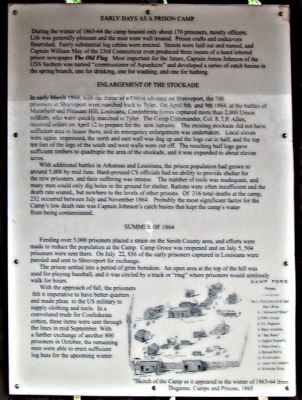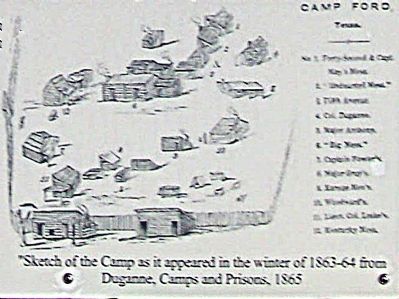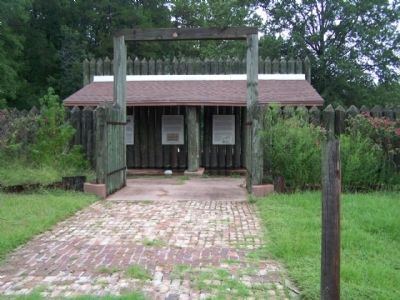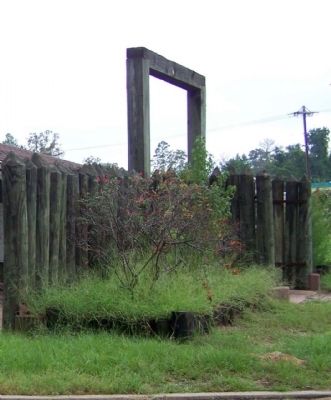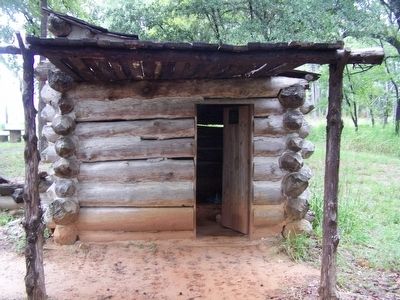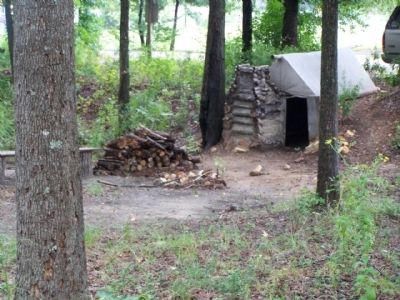Tyler in Smith County, Texas — The American South (West South Central)
Camp Ford - Early Days as a Prison Camp
In early March 1864, with the threat of the Union advance on Shreveport, the 700 prisoners from Shreveport were marched back to Tyler. On April 8th and 9th 1864, at the battled of Mansfield and Pleasant Hill, Louisiana, Confederate forces captured more than 2,000 Union soldiers, who were quickly marched to Tyler. The Camp Commander, Col. R.T.P. Allen, recieved orders on April 12 to prepare for the new inmates. The existing stockade did not have sufficient area to house them, and an emergency enlargement was undertaken. Local slaves were again impressed, the north and east wall dug up and the logs cut in half, and the top ten feet of the logs of the south and west walls were cut off. The resulting half logs gave sufficient timbers to quadruple the area of the stockade, and it was expanded to about eleven acres.
With additional battles in Arkansas and Louisiana, the prison population had grown to around 5,000 by mid June. Hard-pressed CS officials had no ability to provide shelter for the new prisoners, and their suffering was intense. The number of tools was inadequate, and many men could only dig holes in the ground for shelter. Rations were often insufficient and the death rate soared, but nowhere to the levels of other prisons. Of the 316 total deaths at the camp, 232 occurred between July and November 1864. Probably the most significant factor for the Camp's low death rate was Captain Johnson's catch basins that kept the camp's water from being contaminated.
Feeding over 5,000 prisoners placed a strain on the Smith County area, and efforts were made to reduce the population at the Camp. Camp Groce was reopened and on July 4, 504 prisoners were sent there. On July 22, 856 of the early prisoners captured in Louisiana were paroled and sent to Shreveport for exchange.
The prison settled into a period of grim boredom. An open area at the top of the hill was used for playing baseball,
and it was circled by a track or "ring" where prisoners would aimlessly walk for hours.
With the approach of fall, the prisoners felt it imperative to have better quarters and made pleas to the US military to supply clothing and tools. In a convoluted trade for Confederate cotton, those items were sent through the lines in mid September. With further exchange of another 800 prisoners in October, the remaining men were able to erect sufficient log huts for the upcoming winter.
Erected by Smith County Historical Society.
Topics. This historical marker is listed in this topic list: War, US Civil. A significant historical year for this entry is 1864.
Location. 32° 23.779′ N, 95° 16.102′ W. Marker is in Tyler, Texas, in Smith County. Marker is on U.S. 271 near Loop State Highway 323, on the right when traveling north. Touch for map. Marker is in this post office area: Tyler TX 75702, United States of America. Touch for directions.
Other nearby markers. At least 8 other markers are within walking distance of this marker. Camp Ford - Prisoners from Louisiana (here, next to this marker); Camp Ford - Naval Prisoners (here, next to this marker); African Americans at Camp Ford (here, next to this marker); Camp Ford Confederate Guards (here, next to this marker); Camp Ford - Establishment of the Camp (here, next to this marker);
Cabin of Lt. Col. J.B. Leake (within shouting distance of this marker); Camp Ford (about 300 feet away, measured in a direct line); a different marker also named Camp Ford (about 300 feet away). Touch for a list and map of all markers in Tyler.
Regarding Camp Ford - Early Days as a Prison Camp. Camp Ford was the largest Confederate Prisoner of War Camp west of the Mississippi River during the American Civil War. Established in August of 1863, the camp was not closed until May 19, 1865. At its peak in July 1864, over 5,300 prisoners were detained there. (Smith County Historical Society)
Also see . . . The American Civil War - Camp Groce Prisoner of War Camp, as mentioned ... a prison camp was established on some land offered to the state. The land belonged to Leonard W. Groce of the Liendo Plantation, 2.5 miles northeast of Hempstead. This site, one of the earliest cotton plantations in the state, had been used as a training center for Confederate troops when the war started. (Submitted on October 10, 2012, by Mike Stroud of Bluffton, South Carolina.)
Credits. This page was last revised on June 21, 2016. It was originally submitted on October 10, 2012, by Mike Stroud of Bluffton, South Carolina. This page has been viewed 630 times since then and 28 times this year. Photos: 1, 2, 3, 4, 5, 6. submitted on October 10, 2012, by Mike Stroud of Bluffton, South Carolina.
